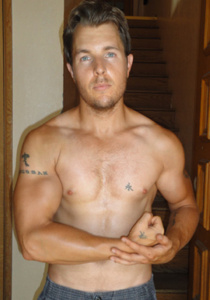On July 1 of this year, the Waterbury Challenge 2011 ended. As a recap, here’s what it was. On January 5, five days into the new year, it started with 5 pull-ups, 5 push-ups, and 5 reverse lunges with each leg. The next day, six days into the year, it was 6 reps of each exercise. From there you were told to add one rep each day until the halfway point of the year, July 1. On that day the workout was 182 pull-ups, push-ups, and reverse lunges with each leg.
The Waterbury Challenge served many purposes. First, it made fitness a part of your daily life. You don’t need to train everyday to get results, but it only helps. Believe or not, I think it’s simpler to train everyday. The less frequently we do something, the more likely it is we’ll miss it. That’s been my experience, anyway.
So I challenged the readers of my site to embark on the challenge. I promised that on July 1 the guy or gal with the fastest time to completion would win $500. About 100 people said they were “in.”
Of course, there was no way for me to know if the competitors did the workouts everyday. A guy could’ve just said he was “in” at the beginning of the challenge and continued to do whatever workout he was doing. In other words, bucking the system I set up was certainly possible. A guy could’ve submitted a video on July 1 doing 182 reps of each exercise, and won, if he had the fastest time to completion.
But that didn’t worry me. I knew if a guy didn’t do the workouts at least 90% of the time he would have major trouble completing the challenge, especially with a respectable time. That’s why I wasn’t surprised at the end of the challenge when only six people submitted a video for my review. (My initial guess was 10 so I wasn’t far off.)
The winner was Damon from Los Angeles. He finished the Waterbury Challenge in just under 22 minutes. That’s an outstanding time and really tough to beat. The nearest competitor took an additional 12 minutes.
Since Damon did a remarkable job, I asked him for a short interview. I thought his input might help you, if you decide to do this type of challenge on your own. Here’s what he had to say.
CW: Excellent job, Damon. What inspired you to do the Waterbury Challenge?
Damon: To be honest, I really wanted to take the challenge to test myself physically and mentally. I was the chubby weak kid that couldn’t even do a “girl pull-up”, and while I have come a long way since school, the thought of doing 182 pull-ups in a single session called out to me. I needed to take part in the challenge, and doing it publicly held me accountable.
CW: So what was your biggest obstacle throughout the challenge?
Damon: For the most part, I had no problems doing the workout each day. I love exercise, so it wasn’t a chore. Although there were some days where I was tired, or feeling weak, I really enjoyed the sessions. However, at the end of March, I sprained a ligament in my left knee, which I am still dealing with even now. There was a week where I could not lunge with the left leg, so I hobbled around doing the chins and push-ups in between resting and icing my knee. That kind of stole my rhythm, so to speak.
CW: There’s an important lesson in that answer. When we get an injury it’s easy to just throw our hands in the air and not do anything. But you powered through like a warrior. Tell me about your recovery. How far into the challenge was soreness a factor? What muscles seemed to get the most sore, and did you get to the point when soreness was completely gone?
Damon: I recovered well and never really hit a wall. I made an effort to mix my grips often to avoid elbow issues. There were moments scattered throughout the months where my back and arms would be sore the following day, but nothing too crazy. The sorest I got was when I started incorporating sets to failure, which I did off and on through April and May.
CW: What about your performance, or your ability to get more reps in each set over time? What did you experience?
Damon: I saw an improvement in my strength, eventually getting to 34 chin-ups in one set. I found that I could do continuous sets of 10 to 12 pull-ups with minimal rest between sets, for 7 to 8 rounds. However, in the end, I began to burn-out, so I lowered the reps to mini sets of 9, which is what I did on the final day.
CW: Did you do any other type of training during the challenge? If so, what did you do, and how did all those pull-ups, push-ups, and lunges affect your outside training?
Damon: I did. I followed a basic 2 days a week plan. Workout A consisted of a push press, pull-up and deadlift. Workout B consisted of incline dumbbell bench press, dumbbell bench assisted row, and split squat. I kept all reps between 5-10 for my gym days. The other days were the challenge only. I feel that this allowed me to recover, and the schedule was easier to keep.
Early in the challenge, I did all pull-ups and lunges with added weight and push-ups with feet elevated. As the numbers went up, I dropped the added weight and increased the reps per set. I feel like the push-ups really helped my pushing strength; I noticed that my vertical pressing went up too. Of course, my physical endurance and mental strength improved as well. After all this time doing such high reps of the pull-up, I can do 7 reps with 45 pounds added, which is amazing for me!
 CW: That’s impressive, for sure. How did your body change, if at all, throughout the challenge?
CW: That’s impressive, for sure. How did your body change, if at all, throughout the challenge?
Damon: I weigh slightly more now, with more muscle, than when I first began the challenge. I have been trying to put on a little size, while staying as lean as possible. Doing the challenging body weight circuit, especially in the later stages, in conjunction with the heavy resistance days worked well for me.
With regard to size, my back and arms grew considerably over the months. I have much more of a v-taper to my back, which has always been one of my top priorities. Obviously, high volume pull-ups do the trick!
CW: It’s my position that frequent body weight exercises for the upper body is one of the best ways to boost arm development. Judging by your forearms and biceps, I think it’s safe to say that holds true! Any last pieces of advice for those who might be interested in this type of challenge?
Damon: Through this experience, I have learned that our bodies are capable of much more than we think. Sometimes, being pushed beyond our limit is a good thing!
CW: Well put, Damon. Congrats!
Damon is a good representation of what a frequent, dedicated training plan will do for your physique, and he has the right mindset. That’s why I was happy to award him the $500 and declare him the winner of the Waterbury Challenge 2011. People can always find reasons to skip trips to the gym, so the challenge was based on exercises you can do at home without equipment. The challenge is a lot of work, but it doesn’t take a lot of time. As Damon said, our body is capable of much more than we think – especially when we avoid doing too much too soon.
You can watch Damon complete the challenge below. Even though he shortened up his range of motion for the pull-up I bit more than I like, his overall performance was so far ahead of the competition that it was easy to name him the winner. Plus, I really dig the rawness of the video that was shot in such a cramped space…
Stay Focused,
CW
